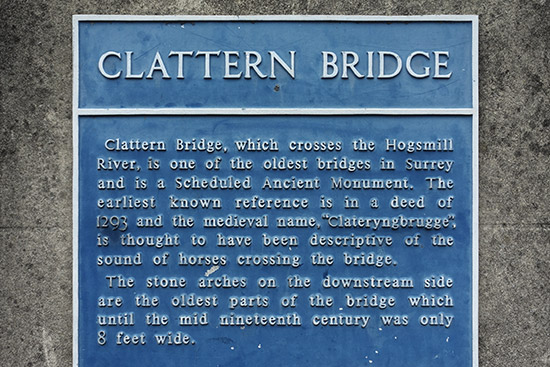Blog
Occasional posts on subjects including field recording, London history and literature, other websites worth looking at, articles in the press, and news of sound-related events.
The clattering bridge
LAST WEEK I was in Kingston-upon-Thames and noticed this explanatory plaque by the Clattern Bridge on the High Street:

On the north side of the bridge there’s a doorway which leads to a flight of steps going down to a path. The path runs a short distance alongside the Hogsmill river to where it joins the Thames.

The Clattern Bridge is likely London’s oldest bridge: Wikipedia claims the current structure was built around 1175, the Londonist says 1293 – I don’t know who’s right. The bridge is still a noisy place with all the traffic of the High Street, a wavering hum of activity rather than the percussive racket of iron-rimmed wheels and horseshoes. One bridge I’ve recorded under still does clatter:
Like the Clattern Bridge, many placenames have humble, straightforward origins: School Road, Drove Road, Cow Lane, Gas Alley. You might expect there to be more bridges with noisy names, and there is indeed a Clatterin Brig in Scotland, about halfway between Dundee and Aberdeen. It gives its name to a Scottish country dance.
In Cumbria there is the Clatter Beck, crossed by Clatter Beck Bridge. It has a stony bed, so perhaps gets its name from the sound of turbulent water. This photograph of Clatter Beck was taken by David Brown and reproduced on Geograph as a Creative Commons-licensed image.

Just before it reaches Kingston, the Hogsmill passes by a sewage works, a football ground and a cemetery; the sort of mosaic of land which appeals to crows and their relatives. The calls of jackdaws are noticeable, and the collective noun for these birds is a clattering.
ABOUT SOUND
FIELD RECORDINGS
The balloonist in the desert is dreaming
The Binaural Diaries of Ollie Hall
GEOGRAPHY AND WANDERINGS
The Ragged Society of Antiquarian Ramblers
LONDON
ORGANISATIONS
Midwest Society for Acoustic Ecology
World Forum for Acoustic Ecology